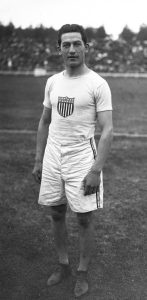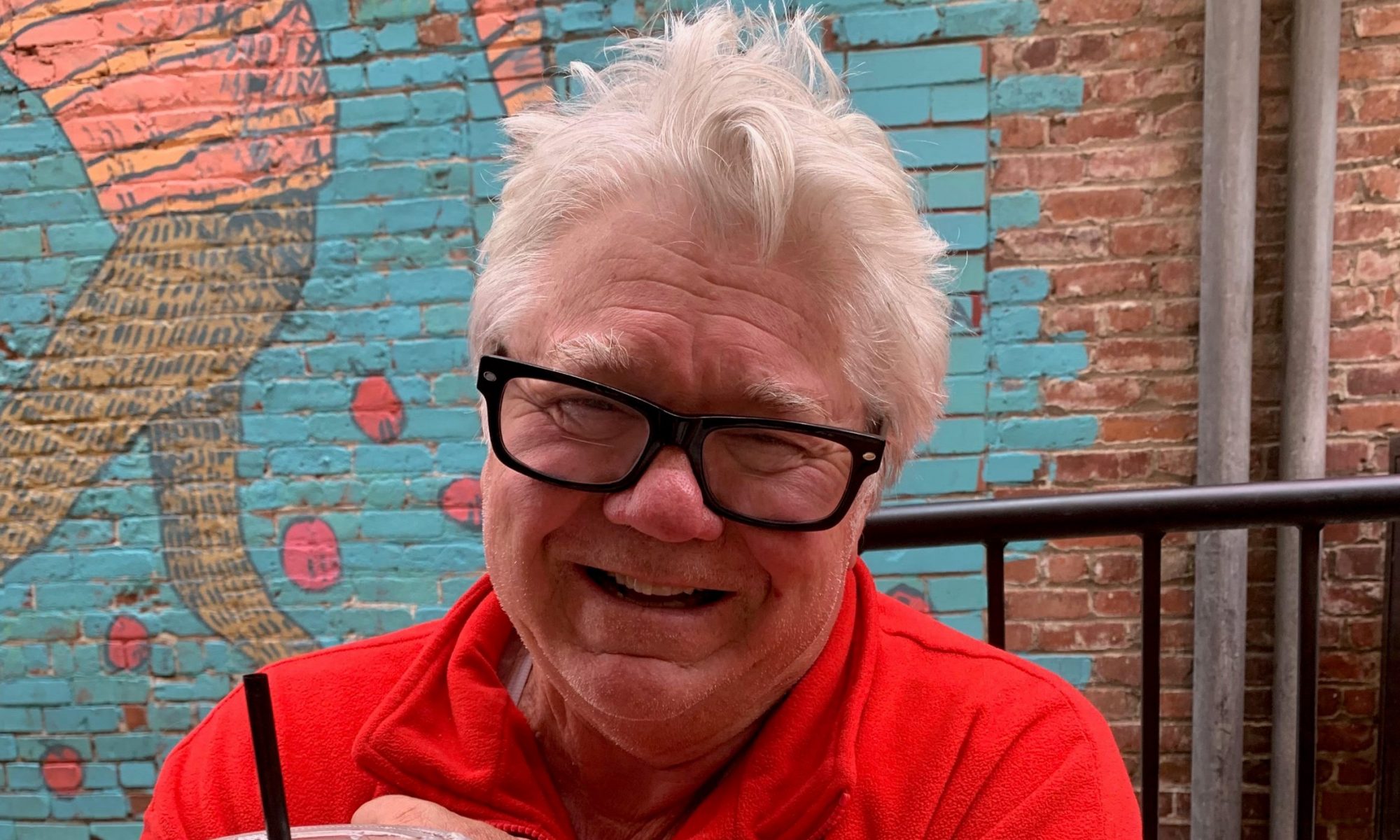A Redlands Connection is a concoction of sports memories emanating from a city that once numbered less than 20,000 people. From pro football’s Super Bowl to baseball’s World Series, from dynamic soccer’s World Cup to golf’s and tennis’ U.S. Open, major auto racing, plus NCAA Final Four connections, Tour de France cycling, more major tennis like Wimbledon, tiny connections to that NBA and a little NHL, major college football, Kentucky Derby, aquatics and Olympic Games, that sparkling little city sits around halfway between Los Angeles and Palm Springs on Interstate 10. Imagine an appearance by an Olympic gold medalist showing up in Redlands over seven decades later.
Abel Kiviat, not very tall, extremely light-weighed, quite an elderly gentleman, an East Coast resident who happened to show up in Southern California along that west coast city, Redlands of all places, as a curious fate.
“I didn’t even know about this. I read about. Had it mentioned to me,” said this man aged into his 90s.
Sure, he told me, “I run a little.”
There’s a reason I asked.
It’s so easy to report this guy was both an Olympic gold and silver medalist – gold in a relay, silver over a 1500-meter race at Stockholm in Sweden, site of those 1912 Olympics.
No one could forget Kiviat scored plenty of world records after 1912. An AAU champion? Sure. Plenty of times, in fact.
Seventy-two years later?

There was, incredibly enough, a 1984 visit at Redlands’ small university for a simple reason. This elderly man, very small, mustached, white-haired all over, Kiviat, Jewish, he told me, was seeking a track record. At first, that’s what I truly thought.
Capturing that silver medal after a 1500-meter run in Stockholm, Sweden, losing to an Oxford guy, Arnold Jackson, was a lengthy memory.
“Yes … of course, I think about it. I was leading … just a little race left,” said Abel, somewhere more than seven decades after gathering across that Atlantic Ocean.
“Disappointing! Really sad for me. I could’ve won. I should’ve won.”
Decades later, there was that visit to Redlands. Just like his 1912 Olympiad in Stockholm, there was no TV coverage.
This visit in Redlands, however, meant something else. A Senior Masters track & field meet was taking place. It was spring, a little chilly. There was a slight bit of attention provided on another runner, a 100-meter guy out there with quite a background, not necessarily in track.
Alan Cranston, a democratic California senator was on hand, running that sprint race in Redlands. Trust me when I say there was other media covering this event simply because of Senator Cranston’s presence.
Hey, he was a great story, no doubt.
Me? I had my eyes on Abel, that Kiviat guy who had a far greater background in this sport.
Kiviat? A winner in Redlands? You bet! Thing is, it was a race for ages 91 through 95. A chance to set an age-level mark in taking two laps around that Redlands track. You bet, Kiviat won. Truth is, he was that age group’s lone racer.
Interview? That would be great.
Staten Island, back in New York? Yes, I had that written down.
A 1912 Olympian in those Stockholm Games? Sure, I knew all about it.
Handfuls of records at a half-mile, other events? Got it.
There was no need, none at all, to seek knowledge that had long been historically printed. Well known. Nothing new. Why re-write a story of Abel that had been reported several times? Something else needed to be written.
*****
Here was my reason for meeting. He was a roommate on that trip from America to Europe, a guy named Jim Thorpe.
That legendary man throughout USA history – track & field, college and professional football, baseball, plus basketball – during his well-remembered years fighting off bitter rules against him being caught playing professional baseball. That wiped out his amateur status, wiping out his 1912 Olympic gold medals for winning decathlon duels.
“Do you have a memory of rooming with Jim Thorpe?”

That’s when my interview with Abel took off. Following his race, he’d been led to a car parked out of Redlands’ stadium. It was chilly. “Hop into that backseat,” I was told by a younger female. You know, avoiding that chill.
I think she was Abel’s great granddaughter.
Abel was jacketed, shaking off slight coolness, just after 7 p.m. Cranston was racing while I spent time with Abel, so I missed that quickly-run sprint with that U.S. Senator. I can’t even recall if he won that race, or not. I didn’t see it.
For a while, it was just Obrey and Abel, sitting in a fairly impressive car just outside that stadium.
“Good guy. I hardly saw Jim,” Abel noted, chuckling. “Yes, sure … he and I were roommates, sure … I saw his trunk of clothes … hardly not him. He was gone a lot. We’d been on that sailing ship together from our country over to Europe.”
Truth is, Abel said with a chuckle, he spotted Thorpe more at Stockholm’s stadium than in their hotel, nor on their ship across Atlantic waters. Thorpe’s teammate threw out a nice smile. Plus, there was a curious memory before they shot over to Sweden.
American athletes stopped in London to train, prepare and live a nice life around that massive England city before sailing over to Europe for The Games.
“That hotel we were at,” noted Abel, “what I’d say was a lot of athletes were trying to touch those high-up lights in their lobby. Guys were tossing money into a hat on a table. Whoever touched that light would win all that cash.”
That light was up there, he said, “maybe 10, 12 feet, I couldn’t tell you, can’t remember it all. Some of us wondered where that money went if no one touched it.”
Money being tossed in, he said, was “probably close to a hundred dollars – a lot, a huge amount in those days.”
Along came Thorpe, Abel noted, his arm tucked into a woman’s arm as they walked into that hotel lobby. Thorpe noted those athletes running, jumping, coming up short of those lobby lights. He filled himself into that off-the-record competitive duel.
“He took off his hat, his jacket, his shoes … his shoes, believe it or not … dropped some money into that hat. Jim made one jump, not only touching that light, but hanging onto it for a few seconds.
“Everyone was amazed at his jumping, not only touching the light but hanging on it. I couldn’t believe it. I still can’t even believe it today.
“No wonder he could win the decathlon.”
I asked Abel if he’d tossed his own cash into that hat. No verbal answers. He just nodded. There was a slight grin. “What an interesting roommate I had at that point,” he told me.
“I can’t remember if Jim put his jacket and hat back on before he grabbed that money, or if he took that money after. Pretty sure he took that cash first. He got back with that woman he was with, then took off.”
It was off to Stockholm for those 1912 Olympic Games.
Seventy-two years later, meeting Abel in Redlands was a joy. Our chat lasted, perhaps, 20 minutes. It would’ve been longer, but I had a sports section to put out by 11 that night. I had to leave for my office. He was heading, apparently, for his hotel somewhere in L.A. county.
Wow!
*****
Thorpe? Took illicit cash? Baseball? New York Giants. Chased away from Olympic’s gold medal. Little did I know that Abel went through that, too.
“I was accused in 1914,” he said, “before an AAU meet. I was disappointed, furious, you name it.”
There wasn’t any chuckling in that short chat.
By 1923, those suspension-minded people allowed Kiviat back.
“People lie. People make mistakes. People take over on things that aren’t proven.”
To me, it was surprising.
*****
A few notes: Seeking a little over a 3-minute, 30-second clocking for a record run over those two laps around that University of Redlands dirt track in 1984, well, Abel didn’t quite make it. He ran well over that mark, but didn’t reach a record that night.
Sure, he’s in USA’s Masters Track & Field Hall of Fame, entered a few years after his Redlands appearance, 1985. Folks like Wilma Rudolph and Lee Evans, Al Oerter and Bob Beamon, plus Thorpe, among dozens of other legends, are atop that list.
Lack of TV? Wait for this. He came out west for one reason. Make a TV appearance. Wish I’d known he came out to appear on Johnny Carson’s late night TV show. I had no idea. I missed it, later discovering that Abel came out west to appear on that program, not necessarily to run that Redlands race.
When he arrived in California, someone mentioned that race to him … in Redlands … give it a try … maybe he’d add to his legendary spot in track & field.
Sure, there were Olympic Games in Los Angeles that year. Abel showed up to help charge that up, too.
Less than a decade later, Abel passed away. He was back east. I was contacted by those who knew him, recalling his visit to Redlands, with me, a nice chat, cheerful information, plus an article. Wish I could’ve jumped on a plane to attend his funeral. He was a year shy of 100.
